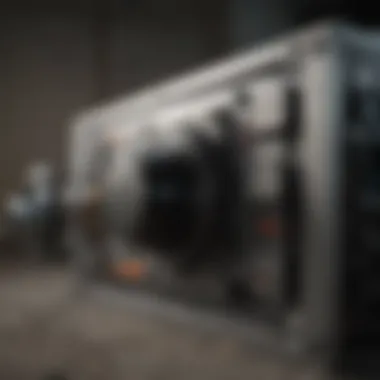Understanding Tripped Breakers and Their Reset Issues


Intro
Understanding why a tripped circuit breaker refuses to reset is crucial for homeowners and industry professionals alike. This article will carefully dissect the myriad reasons causing this frustrating issue. The emphasis will be on the importance of safety while addressing circuit breaker problems, as well as practical troubleshooting techniques that are effective and accessible.
A circuit breaker serves as a vital component in electrical systems, designed to protect both people and property. When a circuit experiences excess current, the breaker trips, interrupting power flow to prevent damage or fires. However, in some instances, it becomes clear that the breaker will not reset after being tripped. This phenomenon can indicate underlying issues that require careful examination.
In this comprehensive guide, we will cover the following key points:
- Common causes behind a breaker not resetting
- Key safety concerns
- Effective troubleshooting methods for homeowners and professionals
- The importance of understanding electrical systems in safe handling of issues
By the end of this article, the reader will gain a thorough understanding of why circuit breakers refuse to cooperate, and this knowledge can prevent unnecessary risks and help maintain the integrity of their electrical systems.
Through this narrative, we aim to cultivate a mindful awareness around electrical safety, stressing the need for caution and informed action when faced with circuit breaker issues.
"Electrical safety is not just a choice; it is a necessity that ensures the well-being of individuals and the preservation of property."
As we delve deeper, practical insights and expert recommendations will come to light.
Intro to Circuit Breakers
Understanding circuit breakers is crucial for anyone who deals with electrical systems. These devices serve as the first line of defense in preventing electrical overloads and faults. They automatically interrupt the flow of electricity under fault conditions, thus protecting both the electrical system and its users. In this article, we will explore the complexities of why a tripped circuit breaker may fail to reset, ensuring a comprehensive grasp of this essential electrical component.
What is a Circuit Breaker?
A circuit breaker is an automatic switch designed to protect electrical circuits from excessive current flow. Unlike a fuse, which must be replaced after it blows, a circuit breaker can be reset. When the electrical load exceeds a predefined limit, or a fault occurs, the breaker trips. Its primary purpose is to prevent overheating, reducing the risk of fire and equipment damage.
Circuit breakers come in various types, including thermal, magnetic, and dual-function breakers. They can be found in homes, commercial buildings, and industrial settings. The proper functioning of these breakers is vital for maintaining safe and efficient electrical systems.
The Function of Circuit Breakers in Electrical Systems
Circuit breakers play a pivotal role in the overall safety and reliability of electrical systems. They interrupt the flow of electricity in case of abnormalities, effectively cutting off the current and minimizing risks. When a breaker trips due to overloading or a short circuit, it is a signal of an underlying issue, necessitating further investigation.
The configuration of a circuit breaker allows for quick disconnection from the power supply, often within milliseconds. This fast action is essential in preventing potential hazards that could lead to serious damage or injury. Additionally, circuit breakers often have features like indicators or alarms, providing visual alerts for tripped conditions. Understanding their function helps in recognizing the importance of routine checks and proper usage in household and industrial settings.
Common Reasons for a Tripped Breaker
Understanding why a breaker trips is crucial for maintaining electrical safety in any environment. Circuit breakers serve as the first line of defense against electrical faults. When a breaker fails to reset, it signals more than just an inconvenience; it indicates potential hazards that require immediate attention. By identifying common reasons for a tripped breaker, homeowners and enthusiasts can help ensure their safety and the longevity of their electrical systems.
The failure to reset a tripped breaker can point toward issues that are often easy to overlook but can lead to dangerous situations. Having a keen awareness of these reasons may facilitate prompt response and effective repairs.
Overloaded Circuit
One of the most frequent causes of a tripped breaker is an overloaded circuit. This occurs when too many devices are connected to a single circuit, consuming more power than it can handle. A circuit is designed with a specific amperage limit, generally 15 or 20 amps, depending on its wiring type. When the combined load exceeds this limit, the breaker trips to prevent overheating and potential fire hazards.


To prevent overloaded circuits:
- Distribute power-consuming devices across multiple circuits.
- Consider reducing the usage of high-draw appliances simultaneously.
- If necessary, consult an electrician to assess and upgrade your circuit load capacity.
Being vigilant can save significant trouble, as continued overloads may eventually cause damage to the wiring.
Short Circuit
A short circuit is another serious reason why a breaker may trip. This occurs when there is a fault in the wiring or an incorrect connection that allows electrical current to travel along an unintended path. Such malfunctions can be dangerous, leading to sparks or even fires.
Common causes of short circuits include:
- Insulation damage on wires.
- Faulty appliances or devices.
- Loose or corroded connections.
When a short circuit occurs, the breaker reacts rapidly, cutting off the current to protect the circuit. Identifying and rectifying short circuits is crucial. Ignoring these signs can lead to severe consequences, including the risk of fire or equipment damage.
Ground Fault
A ground fault is similar to a short circuit, but it specifically refers to an electrical current escaping its intended path and traveling through an unintended route to the ground. This type of fault often occurs in areas where moisture is present, such as kitchens or bathrooms. Ground faults pose a significant risk of electric shock and can lead to more severe electrical hazards.
Ground faults are typically detected by Ground Fault Circuit Interrupters (GFCIs), which cut power upon sensing these faults. It's advisable to:
- Have GFCIs installed where required by code.
- Regularly test GFCIs to ensure they are functioning correctly.
- Look for moisture around outlets and remove sources of water if present.
Understanding these common reasons gives valuable insight into how circuit breakers function and the importance of consistent safety practices in electrical system management.
Why a Tripped Breaker Won't Reset
Understanding why a tripped breaker won’t reset is crucial for various reasons. For homeowners and real estate enthusiasts, dealing with electrical issues can be both confusing and concerning. A breaker that refuses to reset indicates underlying problems that could pose safety hazards. By diagnosing the why, one can take proactive steps to ensure safety within their home and avoid potentially costly electrical repairs down the line.
Understanding the Mechanics of Resetting
A circuit breaker functions as a safety mechanism. Its primary role is to interrupt the electrical flow when it detects an overload or fault in the circuit. When a breaker trips, it must be manually or automatically reset to restore power.
This process of resetting is straightforward. It involves flipping the breaker switch back to the 'on' position. However, if it doesn’t reset, there might be an issue at play. Commonly, this mechanical failure is due to malfunctioning internal components or persistent electrical problems that need addressing.
Potential Electrical Failures
Electrical failures can stem from multiple sources. One significant reason a tripped breaker won't reset is ongoing overloads in the circuit. This condition means too much power is being drawn on one circuit, often due to too many devices being connected simultaneously. In such instances, the breaker will trip repeatedly when an attempt is made to reset it.
Another issue is short circuits. This occurs when a live wire touches a grounded wire or a neutral wire. Such faults can generate a high amount of current, causing the breaker to trip. Lastly, ground faults can also create persistent issues. These faults arise when electricity finds an unintended path to the ground, creating a critical safety risk. Recognizing these electrical failures is essential for troubleshooting and ensuring system integrity.
Age and Condition of the Breaker
The age and condition of a breaker greatly influence its ability to reset. Circuit breakers can wear out over time, particularly if they are frequently tripped. If a breaker is older, it may not have the same capacity to withstand the stress of electrical loads effectively. This wear can cause the breaker to fail in resetting after it trips. Homeowners should periodically assess the condition of their breakers. Signs of wear might include visible rust or brittleness, which might indicate a need for replacement. Keeping track of the age of your circuit breakers can also be beneficial, as some manufacturers recommend replacing them every 10 to 15 years for optimal performance.
Troubleshooting Steps for Breaker Issues
Troubleshooting steps are crucial. A tripped circuit breaker typically signals an issue. Ignoring this can lead to greater problems. The following sections outline practical steps that one can take to identify the cause of the problem. Understanding the sequence of these troubleshooting steps can help maintain safety and prevent damage.


Initial Assessment
Before embarking on any physical checks, the first step is to evaluate the situation. Ask a few questions: What devices were operating when the breaker tripped? Did a specific event coincide with the trip? This helps narrow down possibilities.
During your initial assessment, also determine if the breaker is entirely off or just partially tripped. This distinction can aid in understanding whether a reset might be straightforward or require deeper investigation.
Additionally, make sure to ensure your own safety. If there is any indication of burning smells or hot surfaces, it is wise to refrain from engaging further until a professional can assess it.
Identifying the Load on the Circuit
Every circuit has a load capacity. Understanding this is fundamental. The load measured in amperes should not exceed the breaker rating. If the load regularly approaches the capacity, this could be a cause of repeated tripping.
To identify the load:
- List all devices connected to the circuit.
- Check their individual amperage ratings.
- Sum them up to see if they approach or exceed the breaker's limit.
If the total exceeds the rated capacity, consider redistributing devices across circuits. Reducing the load can solve frequent tripping issues, which will help to reset the breaker more effectively.
Checking for Visible Damage
Physically inspecting the breaker and its surrounding area is an essential troubleshooting step. Visible damage can indicate underlying problems that might prevent a reset. Look for:
- Burn marks or discoloration on the breaker
- Frayed wires or loose connections
- Signs of moisture or corrosion
If any damage is discovered, do not attempt repairs without proper knowledge. This could lead to safety hazards. At this point, it would be prudent to consult with a qualified electrician.
Always prioritize safety over DIY approaches. Assessing risk factors is essential.
Taking comprehensive troubleshooting steps can lead to identifying why a breaker will not reset. This analysis often provides a clearer path forward, whether it be repairs, adjustments, or professional consultations.
When to Call a Professional Electrician
Understanding when to call a professional electrician is crucial for dealing with circuit breaker issues. Not all electrical problems are suitable for DIY solutions. Calling a professional ensures safety and proper handling of complex electrical systems. More importantly, professionals carry the experience and tools necessary to diagnose and correct issues that may not be immediately apparent.
Benefits of Relying on Experts:
- Safety First: Electrical work can be dangerous. Mishandling can lead to electrocution or fire hazards. Professionals can navigate high-risk situations effectively.
- Proper Diagnosis: Many breaker issues stem from hidden problems within the system. An electrician can pinpoint these faults, avoiding guesswork.
- Compliance with Codes: Local electrical codes can be complex. Experienced electricians ensure all repairs or installations meet legal requirements.
- Warranties and Guarantees: Many electricians offer warranties on their work. This provides peace of mind that if problems arise, assistance is available without additional costs.
All these factors help justify the need for professional involvement in electrical work, especially when dealing with preventable issues.
Signs You Need Expert Help
Identifying the right time to seek professional help can save you from potential dangers and costs associated with improper repairs. Here are some signs that signal a need for an expert:


- Frequent Tripping of Breakers: If breakers trip constantly, it may indicate serious issues beyond simple overloads or appliance problems.
- Visible Damage: Burn marks around circuits, wires, or the breaker panel suggest severe electrical issues.
- Burning Smells: Any unusual smells that include electrical components should prompt an immediate call to a professional.
- Sparking or Flickering Lights: This can indicate loose connections or overloading, which requires an expert evaluation.
Always prioritize safety. If you observe any of these signs, it is advisable to involve a professional.
Evaluating the Risk of DIY Repairs
Before attempting any repairs yourself, you should evaluate the potential risks involved. While DIY may seem cost-effective, the realities can differ. Consider the following points:
- Knowledge Gaps: Many homeowners lack the technical knowledge to diagnose complex electrical problems, which could lead to ineffective repairs or further damage.
- Cost of Mistakes: Incorrect repairs may necessitate more extensive work later. Costs can escalate quickly if mistakes happen.
- Equipment Needs: Specialized tools, often required for safe electrical work, might not be readily available to the average homeowner.
- Insurance Risks: If an electrical issue causes damage and you attempt a DIY fix, your insurance may not cover it due to improper handling.
Preventative Measures to Avoid Future Issues
Preventative measures are essential in maintaining a safe and efficient electrical system. Regular attention to the condition of your circuit breakers can prevent issues before they arise. When homeowners take proactive steps, they can minimize the risk of tripped breakers that may fail to reset. This not only enhances safety but also contributes to the overall longevity of the electrical system.
Regular Maintenance Checks
One of the most effective ways to prevent breaker issues is through regular maintenance checks. Regular inspections help to identify potential problems before they escalate into significant hazards. Here are some key steps to consider:
- Schedule Routine Inspections: Annual checks by a qualified electrician can uncover hidden issues.
- Inspect Circuit Breakers: Look for signs of wear or damage. Any discoloration or burning smell can be a warning sign.
- Test the Breakers: Regular testing of the breakers can ensure they respond properly. You can use the test button usually found on the breaker itself.
- Keep the Area Clean: Dust and debris can cause heat buildup, which may affect the breaker's functioning. Keeping the area around the breaker panel clean can help ensure proper ventilation.
This simple checklist can save homeowners from serious electrical failures in the future. Regular maintenance might seem tedious, but the benefits far outweigh the effort.
Upgrading Old Electrical Systems
Upgrading old electrical systems is another vital preventative measure. Many homes still operate on outdated wiring and circuit breakers. These older systems may not handle modern electrical loads or the number of devices people commonly use today.
Consider the following:
- Assess the Age of the System: If your wiring and circuit breakers are over 20 years old, an upgrade is advisable.
- Evaluate the Load Capacity: Many household circuits were designed for fewer appliances than are commonly used today. An assessment will help determine if your system can handle your current usage.
- Replace Inefficient Circuit Breakers: Investing in newer models can improve reliability. Modern circuit breakers have advanced technology that can enhance safety.
- Consult a Professional: A licensed electrician can provide insights on the best upgrades for your specific needs.
As a result of these upgrades, homeowners can not only avoid the frustration of tripped breakers but also enhance the overall safety and efficiency of their homes. The peace of mind gained from knowing your electrical system is sound cannot be overstated.
"Investing in preventative measures and modern upgrades is a responsible choice for any homeowner focused on safety and efficiency."
Culmination
Wrapping up our discussion, understanding the reasons why a tripped breaker won’t reset is crucial for both safety and functionality in electrical systems. This knowledge leads to more informed decision-making regarding home electrical management and maintenance.
Summary of Key Points
- A tripped breaker indicates a problem that needs attention. The reasons can include overloaded circuits, short circuits, and ground faults.
- If the breaker won’t reset, potential issues may stem from faulty wiring, a damaged breaker itself, or safety mechanisms. Each of these factors represents significant risks.
- Troubleshooting involves carefully assessing the situation, and it is sometimes advisable to seek professional help if issues persist.
- Regular maintenance checks and system upgrades can prevent future problems and boost safety.
A clear understanding of these points can help avoid unnecessary risks and ensure the electrical system operates smoothly. Safety should always be the top priority.
The Importance of Electrical Safety
Electrical safety cannot be overstated. Each year, countless incidents in households arise from avoidable electrical failures. Knowledge of how to handle a tripped breaker bolsters personal safety and protects property.
- Recognizing the signs of electrical problems allows homeowners to take timely action.
- Even simple steps, like regular inspections or identifying circuit load capacity, can prevent breakdowns.
- Knowing when to call a professional is invaluable. Some situations exceed basic troubleshooting skills and require expert intervention.
Promoting electrical safety not only protects individuals and property but enhances peace of mind in home environments. Always remember to prioritize knowledge, readiness, and cautious actions with electricity.















